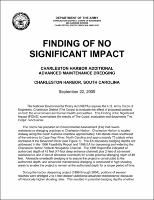Please use this identifier to cite or link to this item:
https://hdl.handle.net/11681/37115Full metadata record
| DC Field | Value | Language |
|---|---|---|
| dc.contributor.author | United States. Army. Corps of Engineers. Charleston District | - |
| dc.date.accessioned | 2020-06-22T17:21:35Z | - |
| dc.date.available | 2020-06-22T17:21:35Z | - |
| dc.date.issued | 2009-09 | - |
| dc.identifier.uri | https://hdl.handle.net/11681/37115 | - |
| dc.description | Environmental Assessment and Finding of No Significant Impact | - |
| dc.description.abstract | Charleston Harbor is located along the mid-South Carolina coast and is one of the busiest ports on the east coast of the US. In 2005, the average annual tonnage was 25.4 million short tons of waterborne commerce and this affects an estimated 260,800 jobs across the state. This Environmental Assessment (EA) covers dredging depths inadvertently not addressed in the 1996 Feasibility Report and EA for Charleston Harbor. The 1996 report indicated an authorized project depth of 45 feet (47 feet entrance channel) plus 2 feet of advanced maintenance and 2 feet of allowable overdepth for a total projected dredging depth of 49 feet. Allowable overdepth is to assure the project is constructed to the authorized depth, and advanced maintenance is conducted in high shoaling areas to enable the project to remain at the authorized depth for a longer period of time. See appendix A for more detailed definition of these terms. The harbor was deepened to the project depth between 1999 and 2004. During this time period, portions of the several reaches were dredged 2-4 feet deeper (additional advanced maintenance) because of historically higher shoaling rates. This resulted in potential dredging depths of either 51 or 53 feet in those areas. Since this deepening, maintenance has been performed on a 12-18 month frequency including the additional advanced maintenance. This additional advanced maintenance in the higher shoaling areas was not addressed in the 1996 Report and is the reason for this EA. The current EA discusses the entire maintenance project to provide an overall project perspective, but the focus is on the impacts of, and need for, continuing with the 2-4 feet of additional advanced maintenance. Two dredging alternatives are discussed: No Action and the proposed project. The same dredging methods and disposal locations are proposed for both alternatives and the disposal locations have at least 20 years of remaining capacity. The no action alternative or status quo is what was discussed in the 1996 Feasibility Report. As indicated above, that report covered a project depth of 45 feet plus 2 feet of advanced maintenance and 2 feet of allowable overdepth for a total potential dredging depth of 49 feet (2 feet deeper in the entrance to allow for wave action). However because of higher shoaling rates in certain areas, a portion of the project would need to be dredged as frequently as twice per year to maintain the project to the authorized depth and allow efficient ship navigation. This would result in an increased annual cost of about $2,085,000 primarily due to more frequent mobilization of dredging equipment and a higher unit cost. For the proposed project, as with the no action alternative, most of the project would be maintained to a project depth of 45 feet plus 2 feet of advanced maintenance and 2 feet of allowable overdepth. However due to higher shoaling rates, portions of the following reaches would continue to be maintained to either 45 feet plus 4 feet of advanced maintenance and 2 feet of allowable overdepth (45+4+2) or 45 feet plus 6 feet of advance maintenance and 2 feet of allowable overdepth (45+6+2): Ordnance Reach and Turning Basin, Lower Wando River, Wando Turning Basin, and Lower Town Creek Reach are all dredged 2 feet deeper (i.e. 45+4+2); and Drum Island Reach is dredged 4 feet deeper (i.e. 45+6+2). These areas with higher shoaling rates are indicated in Figure 2. However unlike the no action alternative, the additional advance maintenance will enable the project to continue to be maintained on a 12 to 18 month frequency. This would result in a decreased annual cost of about $2,085,000 compared to the no action alternative primarily due to less frequent mobilization of dredging equipment and a lower unit cost. Because the additional advanced maintenance areas have already been dredged and have been maintained at the same time as routine maintenance events, no significant environmental impacts are expected from continued maintenance (i.e. proposed project). In addition, if the proposed project is implemented, dredges will be in the harbor less frequently and there will be an average annual savings in dredging costs of $2,085,000. Therefore the proposed project is recommended for long-term maintenance of Charleston Harbor. | en_US |
| dc.description.sponsorship | United States. Army. Corps of Engineers. | en_US |
| dc.format.extent | 70 pages / 3.16 MB | - |
| dc.format.medium | PDF/A | - |
| dc.language.iso | en_US | en_US |
| dc.publisher | United States. Army. Corps of Engineers. Charleston District. | en_US |
| dc.rights | Approved for Public Release; Distribution is Unlimited | - |
| dc.source | This Digital Resource was created in Microsoft Word and Adobe Acrobat | - |
| dc.subject | Charleston Harbor (S.C.) | en_US |
| dc.subject | Dredging | en_US |
| dc.subject | Channels (Hydraulic engineering) | en_US |
| dc.subject | Environmental protection | en_US |
| dc.subject | Environmental management | en_US |
| dc.title | Final Environmental Assessment : Charleston Harbor Additional Advanced Maintenance Dredging, Charleston Harbor, South Carolina | en_US |
| dc.type | Report | en_US |
| Appears in Collections: | Environmental Documents | |
Files in This Item:
| File | Description | Size | Format | |
|---|---|---|---|---|
| Charleston Harbor Additional Advanced Maintenance Dredging EA- Web.pdf | 3.16 MB | Adobe PDF |  View/Open |